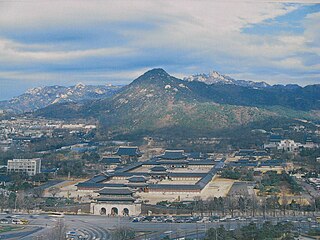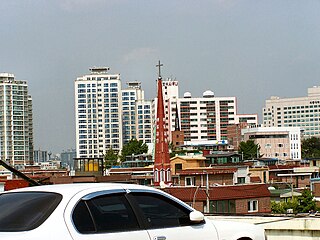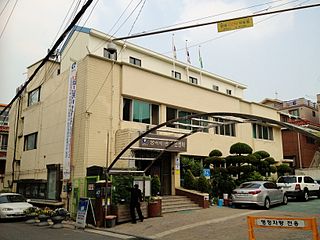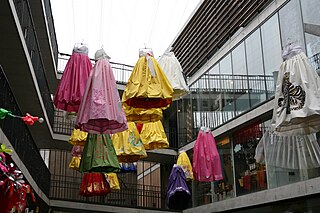
Seongdong District (Seongdong-gu) is one of the 25 gu which make up the city of Seoul, South Korea. It is situated on the north bank of the Han River. It is divided into 20 dong (neighbourhoods).

Jongno District is a district in central Seoul, South Korea. It is the historic center of Seoul, and contains the Joseon-era royal palace Gyeongbokgung and the former presidential residence, the Blue House.

Dongdaemun District is one of the 25 districts of Seoul, South Korea.

Gwangjin District is one of the 25 districts of Seoul, South Korea. It is located on the north bank of the Han River on the eastern end of Seoul. The district was split from the neighboring Seongdong District in 1995.

Gunja-dong is a dong, neighbourhood of Gwangjin-gu in Seoul, South Korea. It is a transportation hub located on the southern side of Cheonho-daero, to the left of Jungnangcheon.

Guui-dong is a dong, neighbourhood of Gwangjin-gu in Seoul, South Korea.

Hwayang-dong is a dong located in west Gwangjin-gu in Seoul, South Korea. It was incorporated into Gwangjin-gu on 13 August 1949. It is a mixed residential and small business area. Mojin-dong is also administered by Hwayang-dong and contains Konkuk University.
Jayang-dong is a dong, neighbourhood of Gwangjin-gu in Seoul, South Korea.

Junggok-dong is a dong, neighbourhood of Gwangjin-gu in Seoul, South Korea.
Neung-dong is a dong, neighbourhood of Gwangjin-gu in Seoul, South Korea.
Noyu-dong is a dong, neighbourhood of Gwangjin-gu in Seoul, South Korea. It is a legal dong administered under its two administrative dong, Jayang 3-dong and Jayang 4-dong.
Mojin-dong is a dong, neighbourhood of Gwangjin-gu in Seoul, South Korea.
Hyoja-dong is a dong, neighbourhood of Jongno-gu in Seoul, South Korea.
Nusang-dong is a dong, neighbourhood of Jongno-gu in Seoul, South Korea. It is a legal dong administered under its administrative dong, Hyoja-dong.
Changseong-dong is a dong, neighbourhood of Jongno-gu in Seoul, South Korea. It is a legal dong administered under its administrative dong, Hyoja-dong.
Ogin-dong (옥인동) is a dong (neighbourhood) of Jongno-gu in Seoul, South Korea. It is a legal dong, administered under its administrative dong, Hyoja-dong, of which it covers the westernmost part, until the fortress wall of Inwangsan.
Tongin-dong is a dong, neighbourhood of Jongno-gu in Seoul, South Korea. It is a legal dong administered under its administrative dong, Hyoja-dong.
Chebu-dong is a dong, neighbourhood of Jongno-gu in Seoul, South Korea. It is a legal dong administered under its administrative dong, Sajik-dong.
Sanggye-dong is a dong (neighbourhood) of Nowon-gu in Seoul, South Korea. It was founded in the 1960s by squatters and by the 1980s there were approximately 1,000 squatter households and 600 tenants. In 1985, it was declared a redevelopment zone. Most people left and some resisted before being evicted forcibly.

Seoul, the capital of South Korea, has many shopping areas and markets throughout the city. Famous ones include Myeong-dong, Cheongdam-dong, the Hongdae area, and the Dongdaemun and Namdaemun markets.









